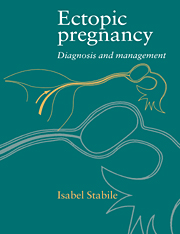Book contents
- Frontmatter
- Contents
- 1 Incidence, aetiology and pathophysiology of ectopic pregnancy
- 2 Clinical presentation of ectopic pregnancy
- 3 Biochemical diagnosis of ectopic pregnancy
- 4 Ultrasound diagnosis of ectopic pregnancy
- 5 Surgical diagnosis
- 6 Practical management of suspected ectopic pregnancy
- 7 Extratubal and unusual ectopic pregnancies
- 8 Medical treatment of ectopic pregnancy
- 9 Conservative and expectant management of ectopic pregnancy
- 10 Radical surgery
- 11 Pregnancy after ectopic pregnancy
- Epilogue: the future
- Index
6 - Practical management of suspected ectopic pregnancy
Published online by Cambridge University Press: 26 March 2010
- Frontmatter
- Contents
- 1 Incidence, aetiology and pathophysiology of ectopic pregnancy
- 2 Clinical presentation of ectopic pregnancy
- 3 Biochemical diagnosis of ectopic pregnancy
- 4 Ultrasound diagnosis of ectopic pregnancy
- 5 Surgical diagnosis
- 6 Practical management of suspected ectopic pregnancy
- 7 Extratubal and unusual ectopic pregnancies
- 8 Medical treatment of ectopic pregnancy
- 9 Conservative and expectant management of ectopic pregnancy
- 10 Radical surgery
- 11 Pregnancy after ectopic pregnancy
- Epilogue: the future
- Index
Summary
Introduction
The missed diagnosis of an ectopic pregnancy accounts for a significant proportion of all malpractice dollar losses in the USA, in part because of the high incidence of the condition and the serious consequences of missing the diagnosis. This high risk of professional liability has led to increasing pressure on gynaecologists to request more and more tests with little regard to resource implications. This chapter addresses the practical management of a suspected ectopic pregnancy in the litigious climate of the 1990s. We shall first examine the diagnostic strategies available in different clinical subgroups. This is followed by a section on the value of very early diagnosis of ectopic pregnancy (i.e. before six weeks of pregnancy).
Symptomatic but clinically stable women: combining ultrasound with biochemical tests
Pelvic sonography and a pregnancy test are often combined to evaluate early pregnancy complications. When attempting to locate the site of pregnancy in a woman with a positive test, attention must be paid to several points. The first is that assuming the human chorionic gonadotrophin (hCG) levels double every two days, there is a delay of 12-14 days between the biochemical detection of implantation (hCG more than 10IU/L) and the identification of a gestational sac by transvaginal sonography (TVS) at hCG levels of more than 1000IU/L (longer delay using transabdominal sonography; TAS). As a result of improvements in the technical quality of available ultrasound equipment, the threshold hCG level at which a gestational sac is always seen has fallen from 6500IU/L (International Reference Preperation; IRP) with TAS to approximately 1000 IU/L (IRP) with TVS (Soussis et al., 1991).
- Type
- Chapter
- Information
- Ectopic PregnancyDiagnosis and Management, pp. 70 - 79Publisher: Cambridge University PressPrint publication year: 1996



